Error Analysis of Clay-Rock Water Content Estimation with Broadband High-Frequency Electromagnetic Sensors—Air Gap Effect
Abstract
:1. Introduction
2. Electromagnetic Properties of Clay Rock
2.1. Materials
2.2. Broadband Dielectric Measurements
2.3. Analysis of Dielectric Spectra
3. 3D Numerical FEM Simulations
3.1. Sensor Configuration
3.2. Electric Field Distribution
3.3. Frequency and Time Signals
3.4. Classical Travel Time Analysis
4. Conclusions
Author Contributions
Conflicts of Interest
References
- The 10th International Conference on Electromagnetic Wave Interaction with Water and Moist Substances (ISEMA). Available online: https://www.arcus.org/19345 (accessed on 18 April 2016).
- Khaled, D.E.; Novas, N.; Gazquez, J.A.; Garcia, R.M.; Manzano-Agugliaro, F. Fruit and vegetable quality assessment via dielectric sensing. Sensors 2015, 15, 15363–15397. [Google Scholar] [CrossRef] [PubMed]
- Wagner, N.; Scheuermann, A. Electromagnetic techniques in geoenvironmental engineering. Environ. Geotech. 2014. [Google Scholar] [CrossRef]
- Robinson, D.A.; Jones, S.B.; Wraith, J.M.; Or, D.; Friedman, S.P. A review of advances in dielectric and electrical conductivity measurement in soils using time domain reflectometry. Vadose Zone J. 2003, 2, 444–475. [Google Scholar] [CrossRef]
- Skierucha, W.; Wilczek, A. A FDR sensor for measuring complex soil dielectric permittivity in the 10–500 MHz frequency range. Sensors 2010, 10, 3314–3329. [Google Scholar] [CrossRef] [PubMed]
- Delay, J.; Lesavre, A.; Wileveau, Y. The French underground research laboratory in Bure as a precursor for deep geological repositories. Rev. Eng. Geol. 2008, 19, 97–111. [Google Scholar]
- Clauzon, T.; Courtois, A.; Moreau, G.; Taillade, F.; Skoczylas, F. Water content monitoring for nuclear concrete buildings: Needs, feedback and industrial qualification. In Proceedings of the Technical Innovation in Nuclear Civil Engineering (TINCE), Paris, France, 28–31 October 2013.
- Buschaert, S.; Lesoille-Delepine, S.; Bertrand, J.; Mayer, S.; Landais, P. Developing the tools for geologic repository monitoring—Andra’s monitoring R & D program. In Proceedings of the WM2012 Conference, Phoenix, AZ, USA, 26 February–1 March 2012.
- Buschaert, S.; Lesoille-Delepine, S.; Bertrand, J.; Landais, P. Andra’s geologic repository monitoring strategy. In Proceedings of the 5th Clays in Natural and Engineered Barriers for Radiocative Waste Confinement, Montpellier, France, 22–25 October 2012.
- Dobson, M.C.; Ulaby, F.T.; Hallikainen, M.T.; El-Rayes, M.A. Microwave dielectric behavior of wet soils—Part II: Dielectric mixing models. IEEE Trans. Geosci. Remote Sens. 1985, GE-23, 35–46. [Google Scholar] [CrossRef]
- Schwartz, R.C.; Evett, S.R.; Pelletier, M.G.; Bell, J.M. Complex permittivity model for time domain reflectometry soil water content sensing: I. Theory. Soil Sci. Soc. Am. J. 2009, 73, 886–897. [Google Scholar] [CrossRef]
- Topp, G.C.; Davis, J.L.; Annan, A.P. Electromagnetic determination of soil water content: Measurement in coaxial transmission lines. Water Resour. Res. 1980, 16, 574–582. [Google Scholar] [CrossRef]
- Rêgo Segundo, A.K.; Martins, J.H.; Monteiro, P.M.D.B.; de Oliveira, R.A.; Freitas, G.M. A novel low-cost instrumentation system for measuring the water content and apparent electrical conductivity of soils. Sensors 2015, 15, 25546–25563. [Google Scholar] [CrossRef] [PubMed]
- Wagner, N.; Bore, T.; Robinet, J.C.; Coehlo, D.; Taillade, F.; Lesoille, S. Dielectric relaxation behaviour of Callovo-Oxfordian clay-rock. J. Geophys. Res. Solid Earth 2013, 118, 4729–4744. [Google Scholar] [CrossRef]
- Bore, T.; Placko, D.; Taillade, F.; Lesoille-Delepine, S.; Six, G.; Sabouroux, P. Theoretical and experimental study of a time-domain-reflectometry (TDR) probe used for water content measurement of clayrock through their electromagnetic properties. In Proceedings of the SPIE 8692, Sensors and Smart Structures Technologies for Civil, Mechanical, and Aerospace Systems, San Diego, CA, USA, 19 April 2013; p. 86921U.
- Feng, W.; Lin, C.P.; Deschamps, R.J.; Drnevich, V.P. Theoretical model of a multisection time domain reflectometry measurement system. Water Resour. Res. 1999, 35, 2321–2331. [Google Scholar] [CrossRef]
- Campbell Scientific. Available online: http://www.campbellsci.com (accessed on 8 April 2016).
- ANSYS. Available online: http://www.ansys.com (accessed on 8 April 2016).
- Lichtenecker, K.; Rother, K. Die Herleitung des logarithmischen Mischungsgesetzes aus allgemeinen Prinzipien der stationären Strömung. Physik. Zeits. 1931, 32, 255–260. [Google Scholar]
- Wagner, N.; Emmerich, K.; Bonitz, F.; Kupfer, K. Experimental investigations on the frequency and temperature dependent dielectric material properties of soil. IEEE Trans. Geosci. Remote Sens. 2011, 47, 2518–2530. [Google Scholar] [CrossRef]
- Gaucher, E.; Robelin, C.; Matray, J.M.; Négrel, G.; Gros, Y.; Heitz, J.F.; Vinsot, A.; Rebours, H.; Cassagnabère, A.; Bouchet, A. ANDRA underground research laboratory: Interpretation of the mineralogical and geochemical data acquired in the Callovian–Oxfordian formation by investigative drilling. Phys. Chem. Earth A/B/C 2004, 29, 55–77. [Google Scholar] [CrossRef]
- Sammartino, S.; Bouchet, A.; Prêt, D.; Parneix, J.C.; Tevissen, E. Spatial distribution of porosity and minerals in clay rocks from the Callovo-Oxfordian formation (Meuse/Haute-Marne, Eastern France) implications on ionic species diffusion and rock sorption capability. Appl. Clay Sci. 2003, 23, 157–166. [Google Scholar] [CrossRef]
- Bore, T.; Wagner, N.; Robinet, J.C.; Coelho, D.; Delepine-Lesoille, S.; Taillade, F.; Six, G. Dielectric properties of Callovo Oxfordian Clay rock. In Proceedings of the 10th International Conference on Electromagnetic Wave Interaction with Water and Moist Substances, Weimar, Germany, 25–27 September 2013; pp. 214–224.
- Bore, T.; Placko, D.; Taillade, F.; Sabouroux, P. Electromagnetic characterization of grouting materials of bridge post tensioned ducts for NDT using capacitive probe. NDT&E Int. 2013, 60, 110–120. [Google Scholar]
- Gorroti, A.; Slob, E. Synthesis of all known analytical permittivity reconstruction techniques of nonmagnetic materials from reflection and transmission measurements. IEEE Trans. Geosci. Remote Sens. 2005, 2, 433–436. [Google Scholar] [CrossRef]
- Jarvis, J.B.; Vanzure, E.J.; Kissick, W.A. Improved technique for determining complex permittivity with the transmission/reflection method. IEEE Trans. Microw. Theory Tech. 1990, 38, 1096–1103. [Google Scholar] [CrossRef]
- Wagner, N.; Trinks, E.; Kupfer, K. Determination of the spatial TDR-sensor characteristics in strong dispersive subsoil using 3D-FEM frequency domain simulations in combination with microwave dielectric spectroscopy. Meas. Sci. Technol. 2007, 18, 1137–1146. [Google Scholar] [CrossRef]
- Vrugt, J.A.; Gupta, H.V.; Boutenand, W.; Sorooshian, S. A shuffled complex evolution metropolis algorithm for optimization and uncertainty assessment of hydrologic model parameters. Water Resour. Res. 2003, 39. [Google Scholar] [CrossRef]
- Heimovaara, T.J.; Huisman, J.A.; Vrugt, J.A.; Bouten, W. Obtaining the spatial distribution of water content along a TDR probe using the SCEM-UA Bayesian inverse modeling scheme. Vadose Zone J. 2006, 3, 1128–1145. [Google Scholar] [CrossRef]
- Wagner, N.; Schwing, M.; Scheuermann, A.A. Numerical 3-D FEM and experimental analysis of the open-ended coaxial line technique for microwave dielectric spectroscopy on soil. IEEE Trans. Geosci. Remote Sens. 2014, 52, 880–893. [Google Scholar] [CrossRef]
- Bore, T.; Wagner, N.; Delepine-Lesoille, S.; Taillade, F.; Six, G.; Daout, F.; Placko, D. 3D-FEM modeling of F/TDR sensors for clay-rock water content measurement in combination with broadband dielectric spectroscopy. In Proceedings of the 2015 IEEE International Sensors Applications Symposium (SAS), Zadar, Croatia, 13–15 April 2015.
- Robinson, D.A.; Schaap, M.; Jones, S.B.; Friedman, S.P.; Gardner, C.M.K. Considerations for Improving the Accuracy of Permittivity Measurement using Time Domain Reflectometry. Soil Sci. Soc. Am. J. 2003, 67, 62–70. [Google Scholar] [CrossRef]
- Robinson, D.A.; Schaap, M.G.; Or, D.; Jones, S.B. On the effective measurement frequency of time domain reflectometry in dispersive and nonconductive dielectric materials. Water Resour. Res. 2005, 41. [Google Scholar] [CrossRef]
- Mironov, V.L.; Dobson, M.C.; Kaupp, V.H.; Komarov, S.A.; Kleshchenko, V.N. Generalized refractive mixing dielectric model for moist soils. IEEE Trans. Geosci. Remote Sens. 2004, 42, 773–785. [Google Scholar] [CrossRef]
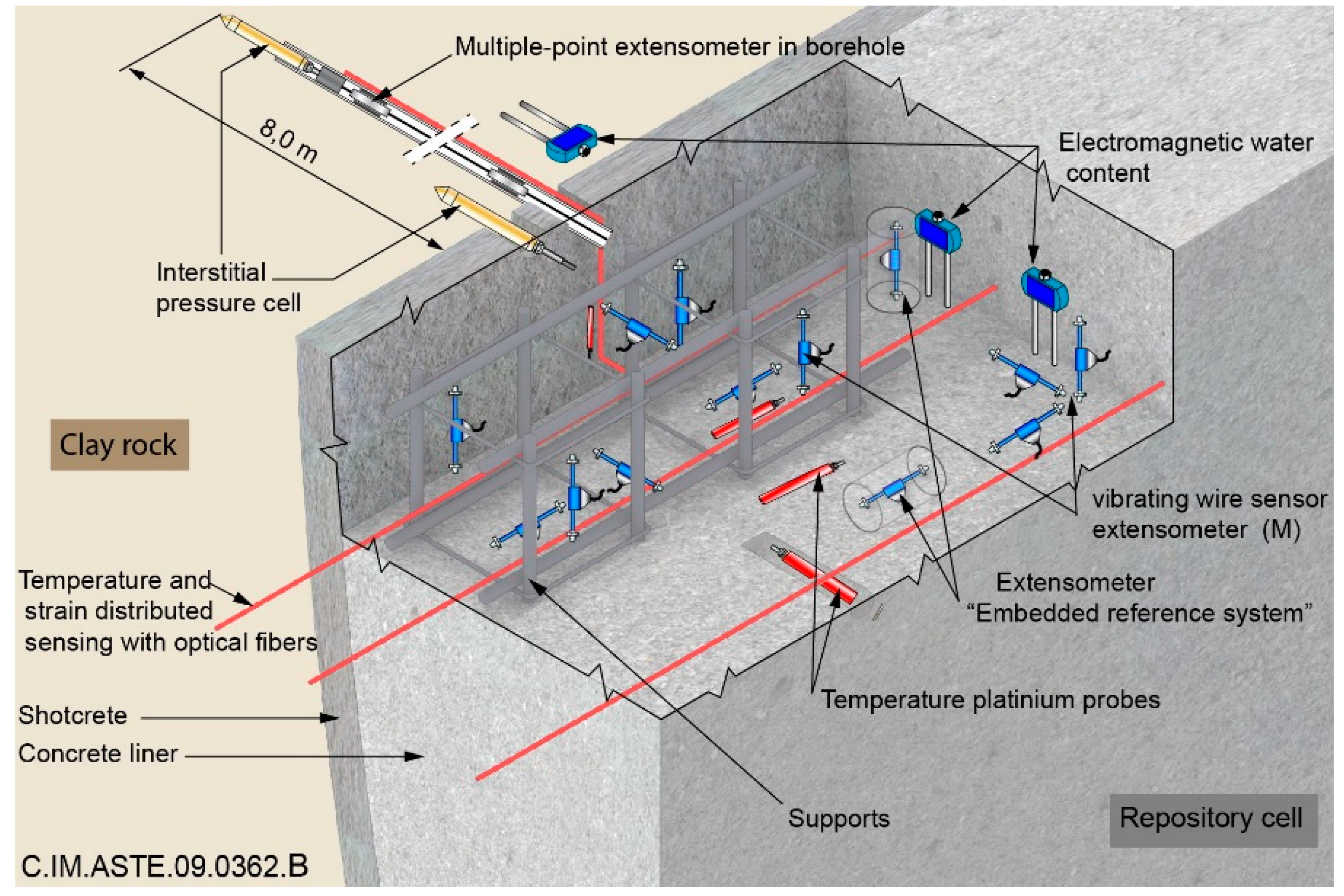
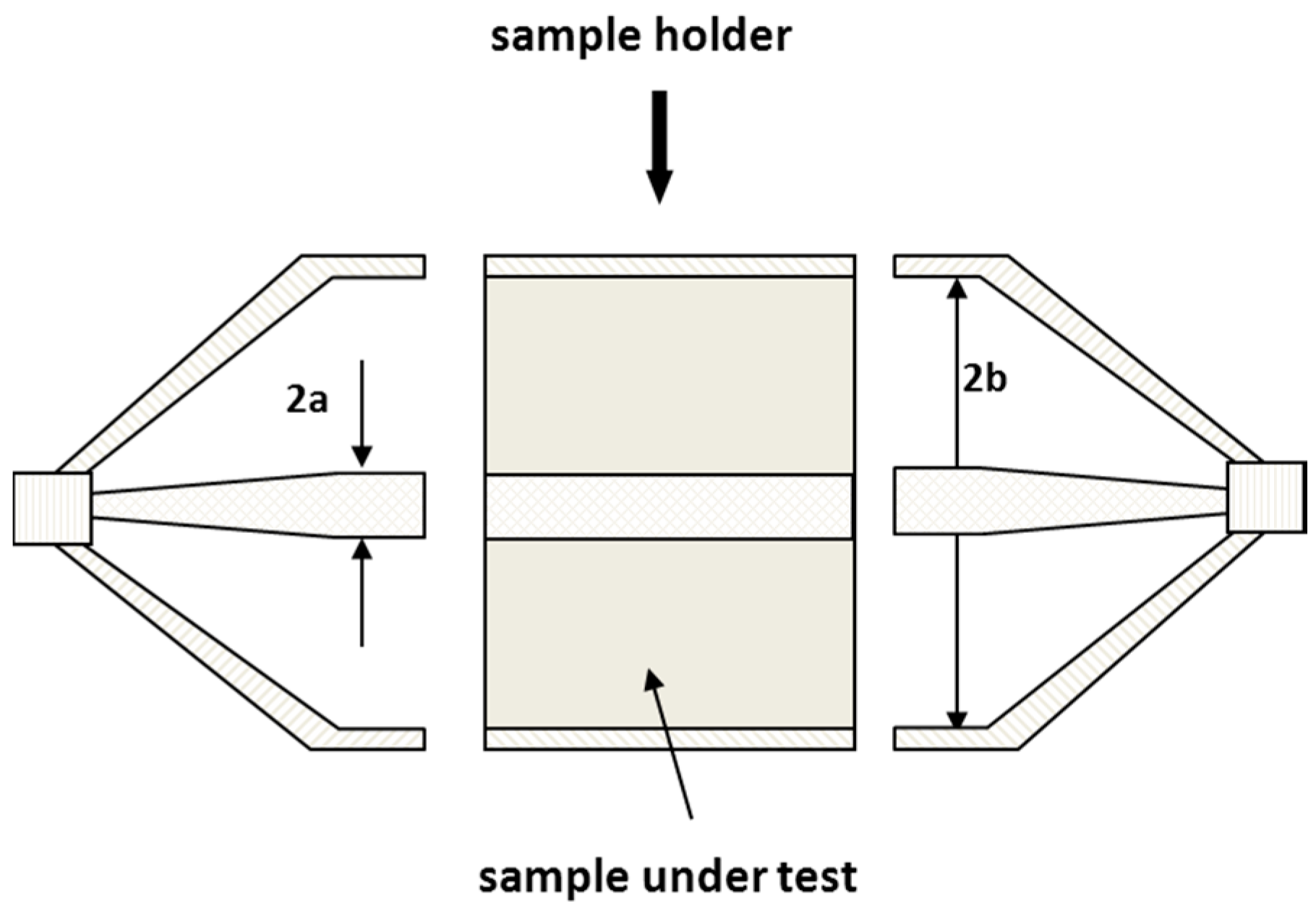
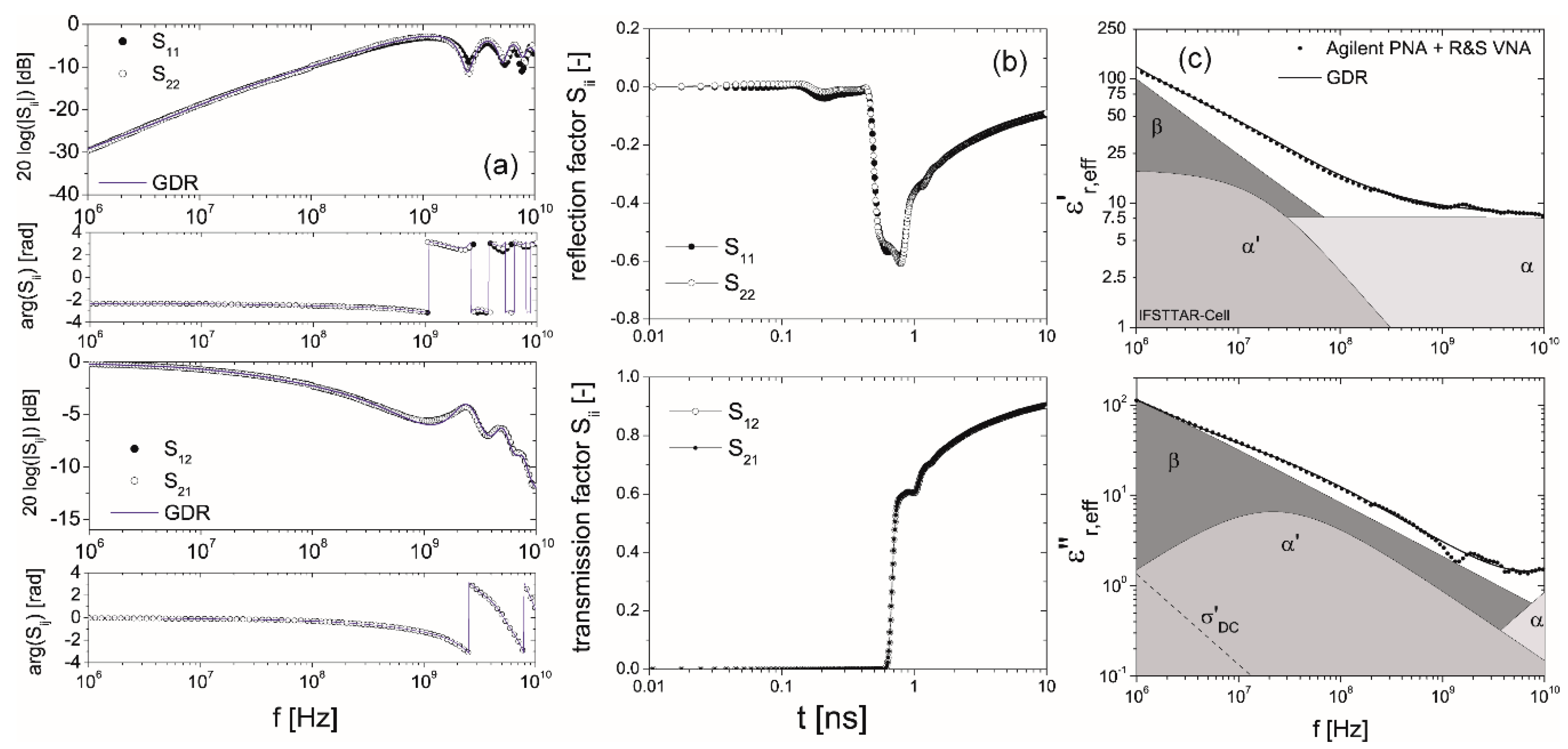
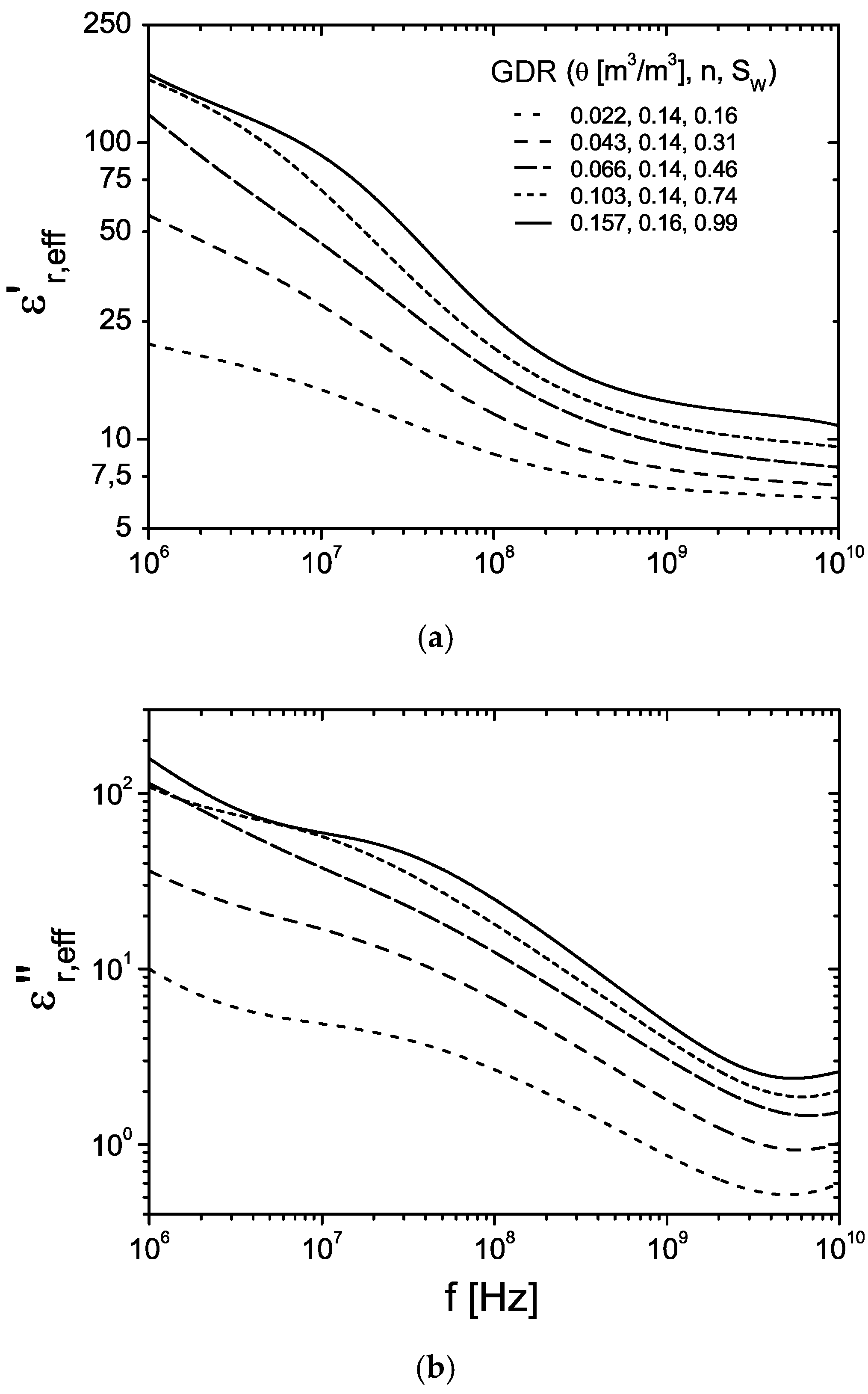
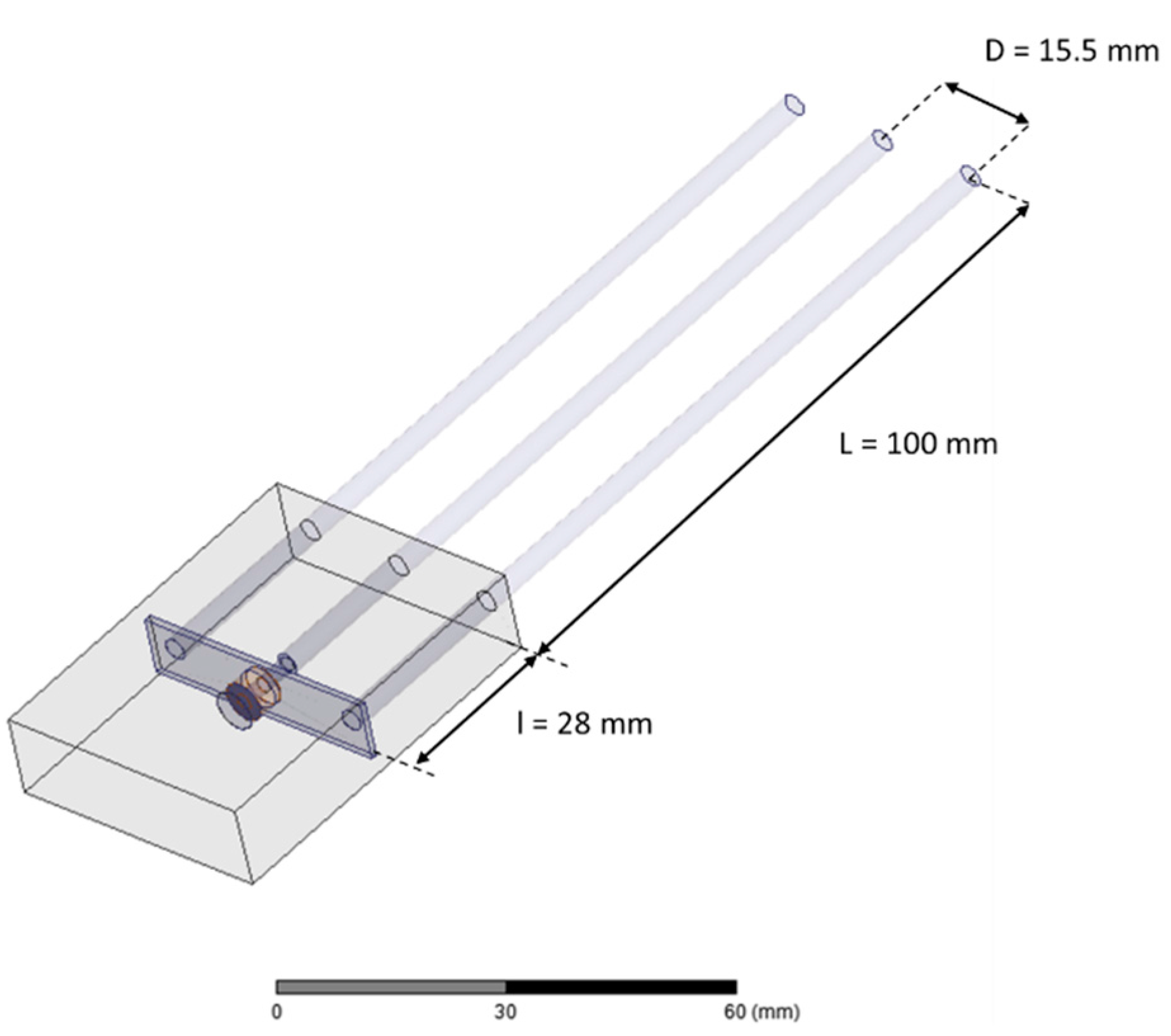
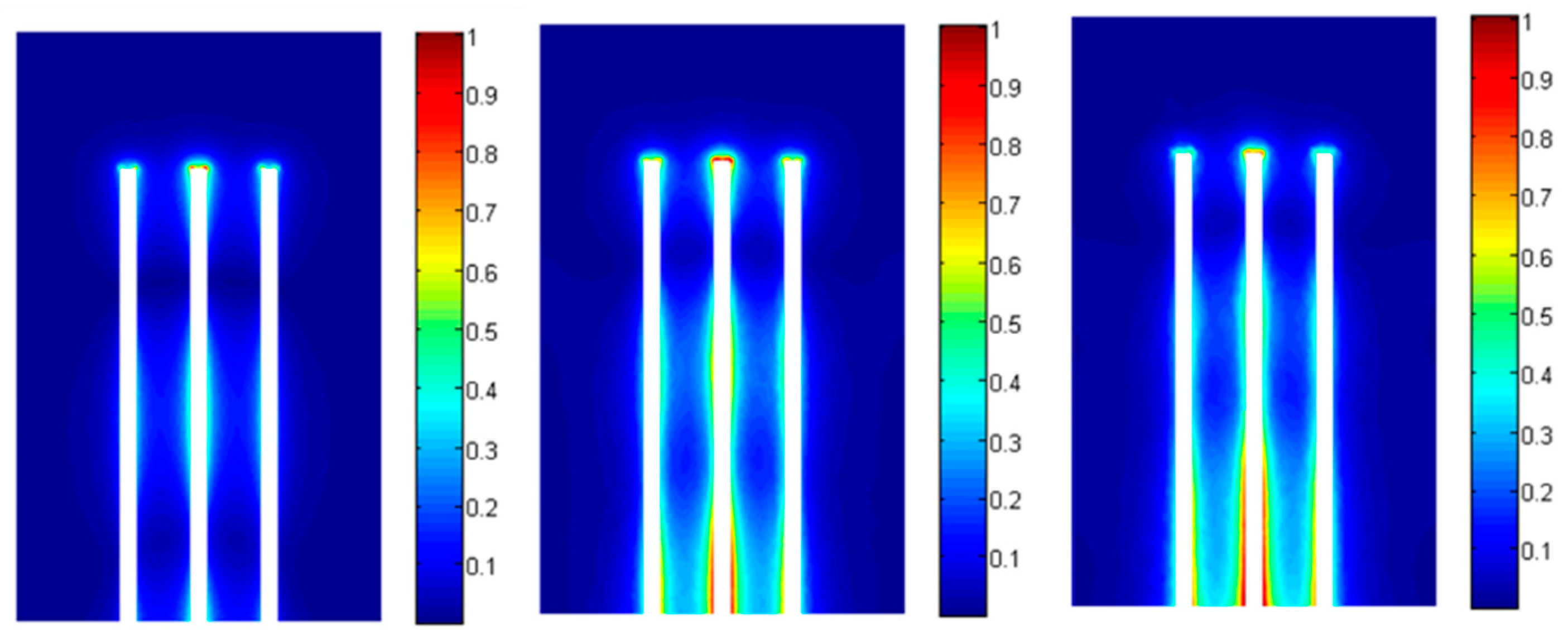
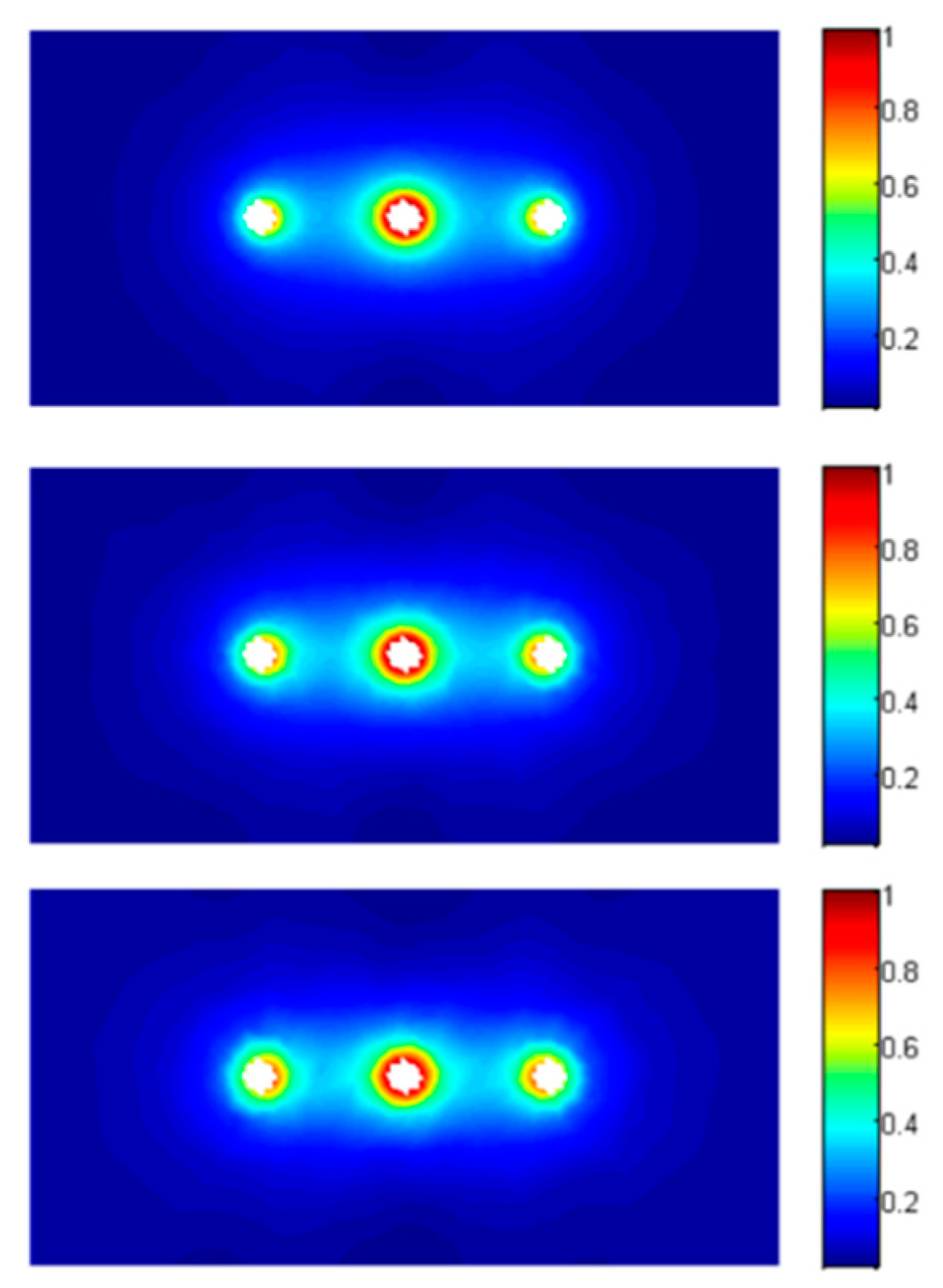

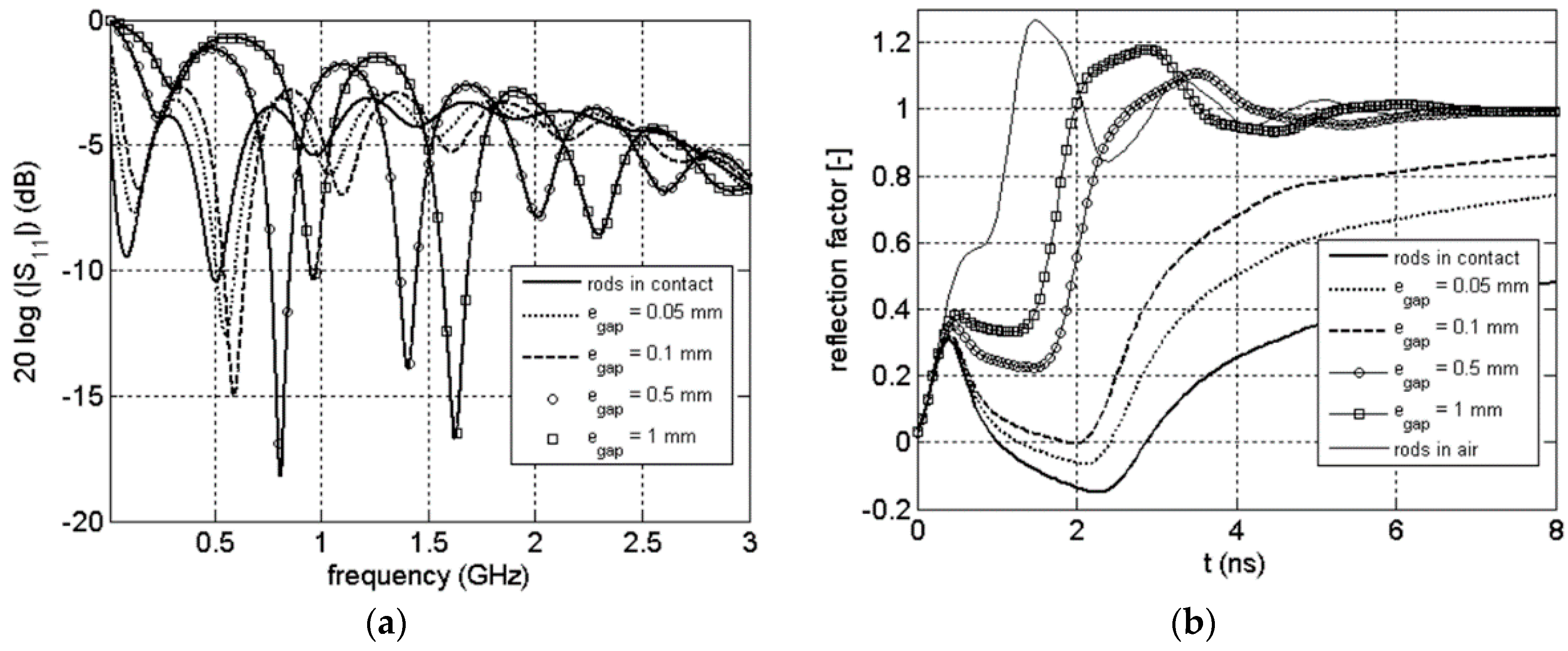

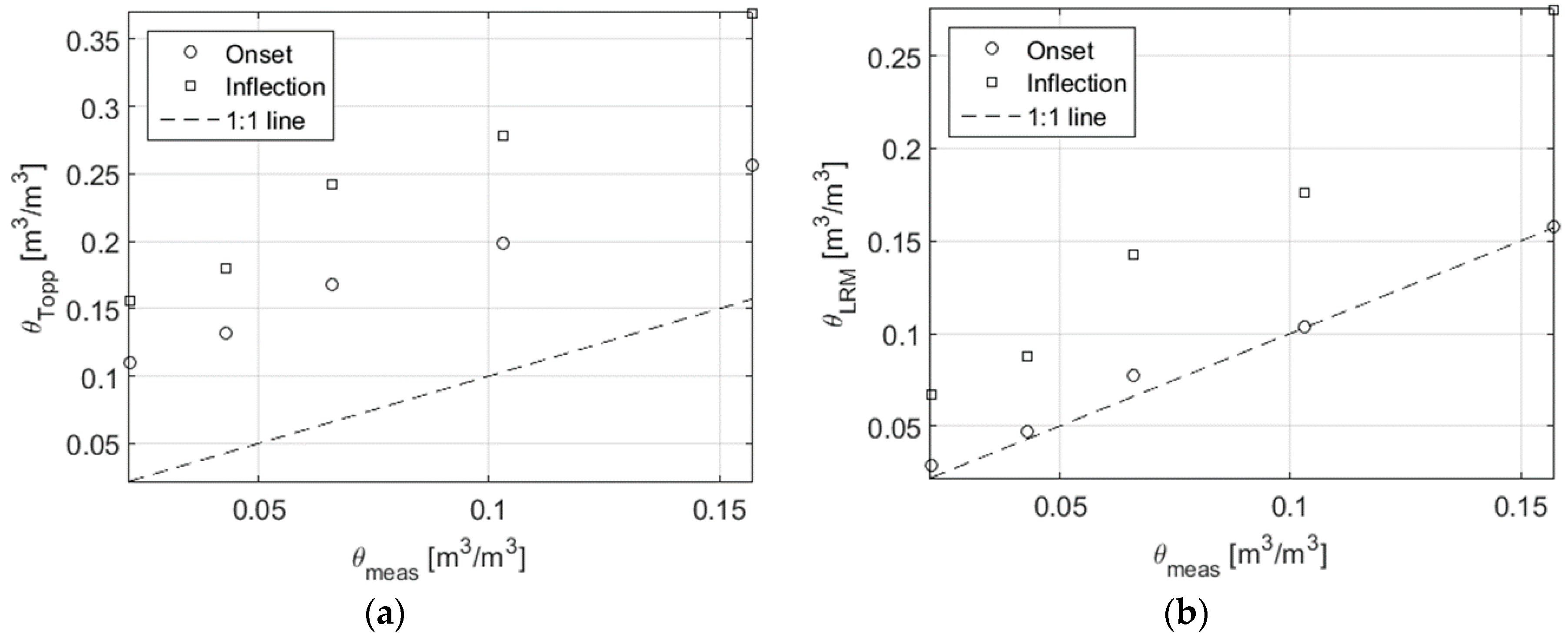
| ϕ (%) | θ (m3/m3) | n (-) | SW (-) | εS (-) | ε∞ (-) | Δεα (-) | τα (ps) | Δεα’ (-) | τα’(ns) | 1–aα’ (-) | Δεβ (-) | τβ (μs) | 1–aβ (-) | σDC (μs/m) |
|---|---|---|---|---|---|---|---|---|---|---|---|---|---|---|
| 11.1 | 0.022 | 0.136 | 0.160 | 6.21 | 1.50 | 4.72 | 1.35 | 13.2 | 10.1 | 0.383 | 789 | 74.4 | 0.27 | 0.08 |
| 33.0 | 0.043 | 0.140 | 0.306 | 6.81 | 1.48 | 5.33 | 1.83 | 36.2 | 17.5 | 0.353 | 1069 | 30.0 | 0.33 | 0.05 |
| 57.7 | 0.066 | 0.144 | 0.458 | 7.71 | 1.73 | 5.98 | 2.33 | 20.1 | 7.6 | 0.234 | 1312 | 5.3 | 0.40 | 0.05 |
| 75.3 | 0.103 | 0.139 | 0.740 | 9.29 | 4.11 | 5.18 | 4.35 | 129.9 | 20.8 | 0.276 | 1148 | 25.1 | 0.27 | 0.06 |
| 99.9 | 0.157 | 0.158 | 0.991 | 11.06 | 8.19 | 2.87 | 7.77 | 172.1 | 20.0 | 0.31 | 24,115 | 90.9 | 0.005 | 4.6 |
| Perfect Contact | Presence off the Air Gap | |||||||
|---|---|---|---|---|---|---|---|---|
| ε‘f,eff @ 1 GHz | εapp | egap = 0.05 mm εapp | egap = 0.1 mm εapp | egap = 0.2 mm εapp | egap = 0.3 mm εapp | egap = 0.4 mm εapp | egap = 0.5 mm εapp | |
| air | - | 1.037 | - | - | - | - | - | - |
| clay rock θ = 0.022 | 6.843 | 6.280 | 5.707 (0.09) | 4.769 (0.24) | 4.160 (0.34) | 3.650 (0.42) | 3.306 (0.47) | 3.023 (0.52) |
| clay rock θ = 0.043 | 7.907 | 7.270 | 6.529 (0.10) | 5.929 (0.18) | 4.608 (0.34) | 4.039 (0.44) | 3.591 (0.50) | 3.245 (0.55) |
| clay rock θ = 0.066 | 9.613 | 8.966 | 7.890 (0.12) | 7.027 (0.22) | 5.832 (0.35) | 4.574 (0.49) | 4.016 (0.55) | 3.589 (0.60) |
| clay rock θ = 0.103 | 11.04 | 10.533 | 8.989 (0.15) | 7.925 (0.25) | 6.429 (0.39) | 5.423 (0.48) | 4.320 (0.59) | 3.811 (0.64) |
| clay rock θ = 0.157 | 14.04 | 13.814 | 11.390 (0.17) | 9.626 (0.30) | 7.461 (0.46) | 6.125 (0.56) | 5.240 (0.62) | 4.191 (0.70) |
| Perfect Contact | Presence off the Air Gap | |||||||
|---|---|---|---|---|---|---|---|---|
| ε‘f,eff @ 1 GHz | εapp | egap = 0.05 mm εapp | egap = 0.1 mm εapp | egap = 0.2 mm εapp | egap = 0.3 mm εapp | egap = 0.4 mm εapp | egap = 0.5 mm εapp | |
| air | - | 1.623 | - | - | - | - | - | - |
| clay rock θ = 0.022 | 6.843 | 8.397 | 7.828 (0.06) | 6.750 (0.20) | 5.751 (0.31) | 5.282 (0.37) | 4.833 (0.42) | 4.403 (0.47) |
| clay rock θ = 0.043 | 7.907 | 9.595 | 8.986 (0.06) | 8.397 (0.12) | 6.750 (0.30) | 5.751 (0.40) | 5.282 (0.45) | 4.833 (0.50) |
| clay rock θ = 0.066 | 9.613 | 12.94 | 10.873 (0.16) | 9.595 (0.26) | 8.397 (0.35) | 6.750 (0.48) | 5.751 (0.55) | 5.282 (0.59) |
| clay rock θ = 0.103 | 11.04 | 15.187 | 12.231 (0.19) | 10.873 (0.28) | 8.986 (0.41) | 7.828 (0.48) | 6.240 (0.59) | 5.751 (0.62) |
| clay rock θ = 0.157 | 14.04 | 22.056 | 15.975 (0.27) | 13.669 (0.38) | 10.224 (0.54) | 8.986 (0.59) | 7.828 (0.64) | 6.240 (0.71) |
| Perfect Contact | Presence off the Air Gap | ||||||
|---|---|---|---|---|---|---|---|
| egap = 0.05 mm | egap = 0.1 mm | egap = 0.2 mm | egap = 0.3 mm | egap = 0.4 mm | egap = 0.5 mm | ||
| θ = 0.022 | 0.294 | 0.205 | 1.052 | 1.626 | 2.125 | 2.472 | 2.765 |
| θ = 0.043 | 0.099 | 0.219 | 0.484 | 1.093 | 1.370 | 1.596 | 1.775 |
| θ = 0.066 | 0.176 | 0.109 | 0.345 | 0.686 | 1.065 | 1.242 | 1.382 |
| θ = 0.103 | 0.004 | 0.248 | 0.428 | 0.693 | 0.881 | 1.098 | 1.203 |
| θ = 0.157 | 0.002 | 0.240 | 0.425 | 0.665 | 0.823 | 0.932 | 1.069 |
© 2016 by the authors; licensee MDPI, Basel, Switzerland. This article is an open access article distributed under the terms and conditions of the Creative Commons Attribution (CC-BY) license (http://creativecommons.org/licenses/by/4.0/).
Share and Cite
Bore, T.; Wagner, N.; Delepine Lesoille, S.; Taillade, F.; Six, G.; Daout, F.; Placko, D. Error Analysis of Clay-Rock Water Content Estimation with Broadband High-Frequency Electromagnetic Sensors—Air Gap Effect. Sensors 2016, 16, 554. https://doi.org/10.3390/s16040554
Bore T, Wagner N, Delepine Lesoille S, Taillade F, Six G, Daout F, Placko D. Error Analysis of Clay-Rock Water Content Estimation with Broadband High-Frequency Electromagnetic Sensors—Air Gap Effect. Sensors. 2016; 16(4):554. https://doi.org/10.3390/s16040554
Chicago/Turabian StyleBore, Thierry, Norman Wagner, Sylvie Delepine Lesoille, Frederic Taillade, Gonzague Six, Franck Daout, and Dominique Placko. 2016. "Error Analysis of Clay-Rock Water Content Estimation with Broadband High-Frequency Electromagnetic Sensors—Air Gap Effect" Sensors 16, no. 4: 554. https://doi.org/10.3390/s16040554






